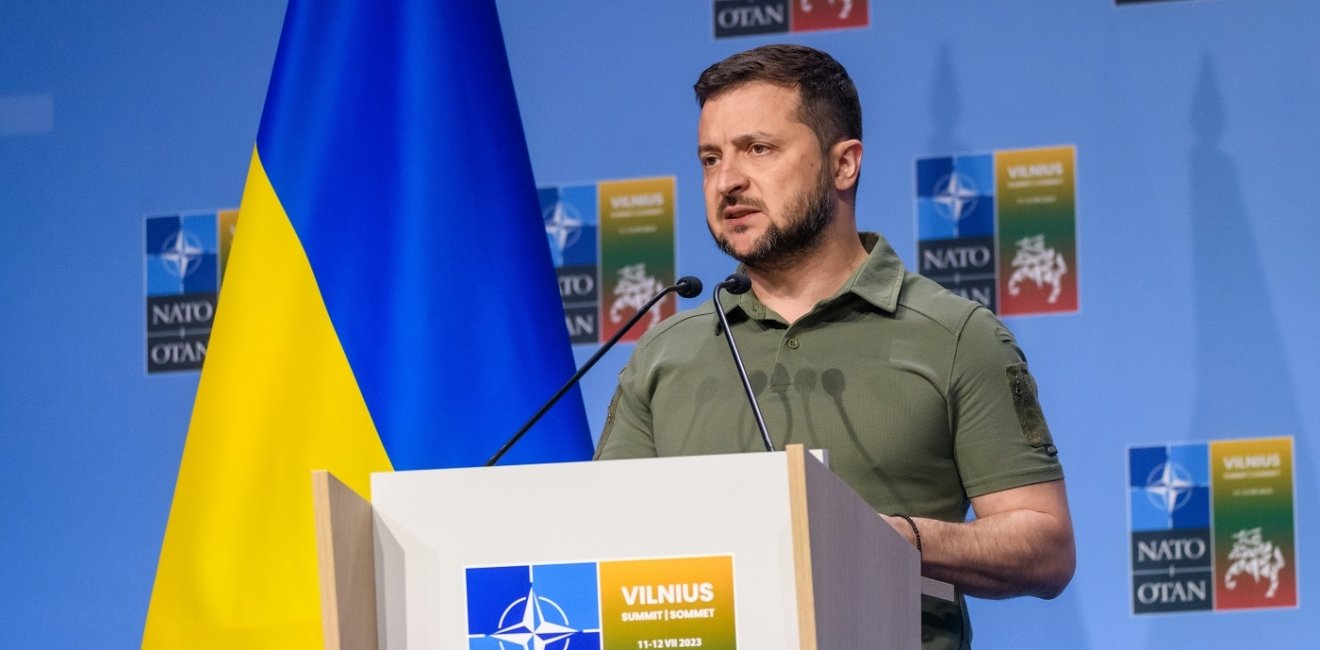
A blog of the Kennan Institute
VILNIUS—Many Ukrainians and Ukraine supporters have described the NATO summit that concluded this past week in Vilnius, Lithuania, as disappointing. Ukraine did not get a formal invitation to join the alliance or an exact timeline for accession. Yet security prospects are much brighter for Ukraine than it might seem.
Of course, joining the institutions of the West, including NATO and the European Union, would represent a definitive milestone in Ukraine’s European journey. But the fact that a formal invitation is a relatively distant goal was clear long before the summit. Regardless of the current state of accession negotiations, the path to joining major Western organizations lies through deep institutional change that takes years even in peacetime.
Considering the ongoing hostilities and the West’s somewhat irrational fears of a Russian escalation, it is premature to anticipate NATO majors might formalize a relationship with Ukraine through a binding collective treaty. Politicians in Washington, Berlin, or Paris are loath to confront Russia in an all-out war that would be triggered by the NATO Treaty’s Article 5, which considers an armed attack against one member an attack against all.
Western politicians also must consider constituencies that hold ambivalent attitudes toward Russia's aggression or are tired of their country’s support of Ukraine. In a recent issue of the Deutschlandtrend survey, a majority, or 55 percent, of those polled said the German government should intensify its push for negotiations to end the fighting. Forty-one percent of those polled in Italy, 39 percent in Germany, and 31 percent in France, in a different poll, said it was important to stop the war as soon as possible even if it meant ceding control of some areas to Russia.
But there is a workable, if temporary, alternative to a binding collective treaty that has been discussed before and during the summit: a system of bilateral security ties with major military powers. During the summit, Canada, France, Germany, Italy, Japan, the U.K. and the U.S. have proposed just that. The G7 countries suggested that each of them, in a national capacity, would be ready to take up bilateral, long-term security commitments to arm Ukraine and help it liberate itself.
One benchmark example of such an arrangement is Israel’s decades-long experience of fending off aggression and providing its own security, helped mainly by the world’s preeminent military power, the U.S.
The Israel security model was born out of necessity and developed organically over many decades. It is not a formal military bloc for reasons similar to those present today in Ukraine’s case. Since its creation, Israel has faced a threat to its very existence, has often been at war, while actively defending itself in a hostile environment. When the Israeli-U.S. cooperation was developing it had a Cold War dimension too. Israel needed support, while U.S. politicians were scrambling to deter threats emanating from Moscow-friendly regimes and forces in the Middle East.
It took a long time for Israel to reach today’s level of support, which includes substantial arms transfers, security guarantees, political support, and cooperation in research and development. This is rooted not in a security treaty, but in a policy, a broad, bipartisan, and multifaceted one.
The U.S. and Israel never entered into an official alliance. In 1981, under President Ronald Reagan and the Israeli prime minister Menachem Begin, the two countries formalized their strategic cooperation in the form of a Memorandum of Understanding, an act of the executive branch not subject to Senate ratification.
The agreement included a set amount of U.S. military aid, a commitment to joint military exercises, the U.S.’s Sixth Fleet’s ability to use Israeli ports, and a trade agreement. The cooperation between the two countries has grown and expanded ever since. It started under a charismatic Republican, Reagan, and reached its present scale under a charismatic Democrat, Barack Obama, who wanted the Israeli aid agreement to be part of his legacy.
In 1981, the amount of aid was set at $425 million a year. In 2016, it reached $3.8 billion a year. In 2016, under the administrations of Obama and Prime Minister Benjamin Netanyahu, the two countries signed a defense aid agreement that promised Israel $38 billion over 10 years, from 2019 to 2028. The agreement succeeded a previous one that had provisions for $30 billion in aid between 2007 and 2018.
Just like Ukraine today, Israel faced numerically superior forces in the region. To address the issue, the U.S. undertook to maintain Israel’s “qualitative military edge,” that is, promised that the Israeli army would always have an advantage in terms of the quality of its military equipment over its potential adversaries.
Ukraine is well positioned to walk a similar path. In fact, it has been following this path for the entire duration of Russia’s full-scale war against Ukraine. The amount of aid the U.S. has pledged to Ukraine is already comparable to the amounts given to Israel over the course of the past three decades. The assistance coming from other countries is also significant.
According to the Kiel Institute for the World Economy, throughout the year and a half of Russia’s war against Ukraine, the Biden administration and the U.S. Congress have provided Ukraine with more than $75 billion in assistance, including humanitarian, financial, and military support.
Aid provided by Ukraine’s other allies has somewhat slowed during the past months. Yet it has been steady and now amounts to a grand total of 165 billion euros, of which 9 billion is military aid. Germany, which is often criticized for being the most cautious of all Western powers, is, in absolute terms, the second biggest contributor of military aid to Ukraine. Germany’s military pledges recently reached 7.5 billion euros.
The most important goal for Ukrainian politicians now is to turn the current emergency assistance into a sustainable strategic partnership. There is every reason to believe that, with smart diplomacy and effort, Kyiv will be able to build a “Ukraine security model.” Since Ukraine is likely to remain the West’s non-treaty ally for quite some time, it makes sense to invest in bilateral relations with all of those nations that have expressed support for Ukraine’s cause.
As Israeli politicians would tell you, their lesson is that a strategic relationship, just like any relationship, does not materialize all by itself but requires a lot of work. This work, on all diplomatic tiers and societal levels, has to be maintained steadily regardless of the situation on the battlefield. The last but not least important aspect of this journey for any country is to establish and maintain its political independence in the face of influential partners. The Israeli model could be an inspiration on this as well.
The opinions expressed in this article are those solely of the author and do not reflect the views of the Kennan Institute.
Author

Editor-at-Large, Meduza

Kennan Institute
After more than 50 years as a vital part of the Wilson Center legacy, the Kennan Institute has become an independent think tank. You can find the current website for the Kennan Institute at kennaninstitute.org. Please look for future announcements about partnership activities between the Wilson Center and the Kennan Institute at Wilson Center Press Room. The Kennan Institute is the premier US center for advanced research on Eurasia and the oldest and largest regional program at the Woodrow Wilson International Center for Scholars. The Kennan Institute is committed to improving American understanding of Russia, Ukraine, Central Asia, the South Caucasus, and the surrounding region through research and exchange. Read more

Explore More in The Russia File
Browse The Russia File
Chechnya as a Model of Modern Russia

Russia’s Indigenous Communities and the War in Ukraine

Gas and Power in a Changing US–Russia Relationship

